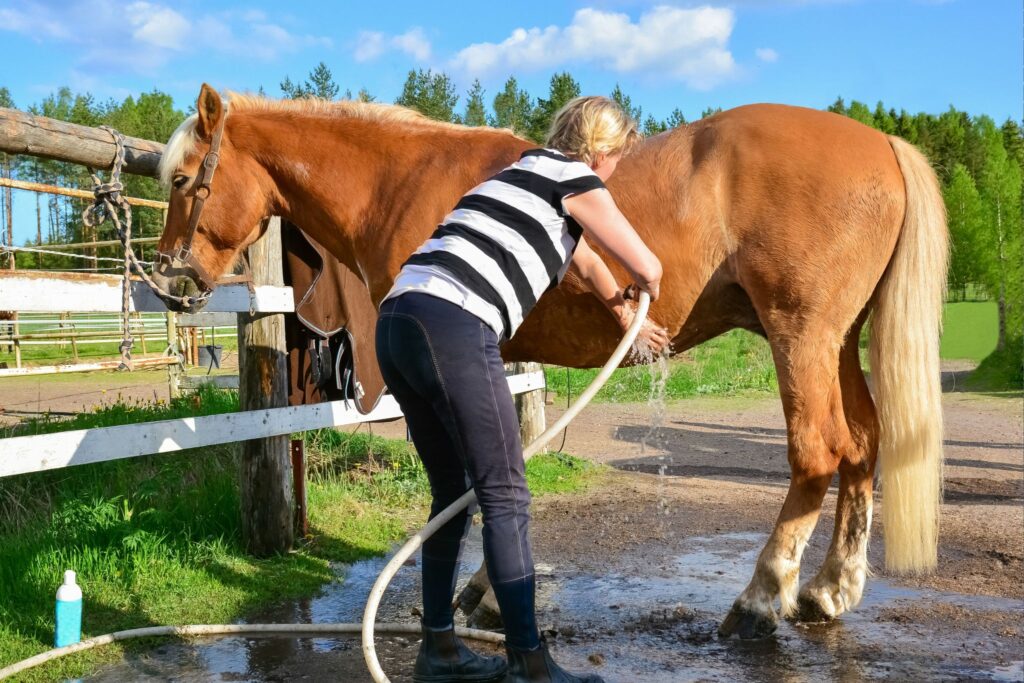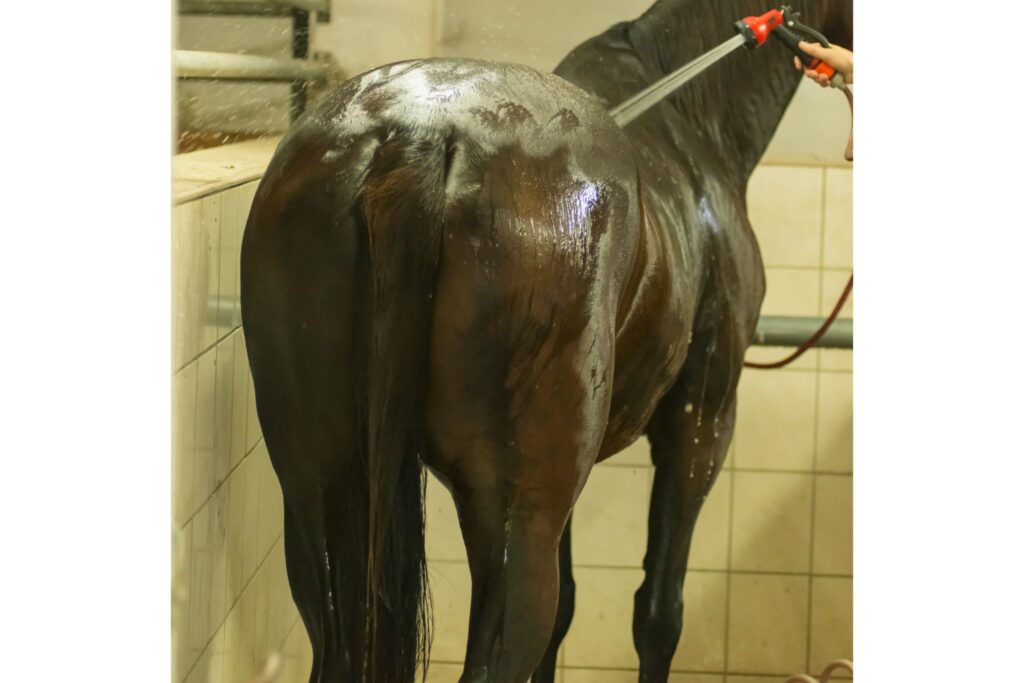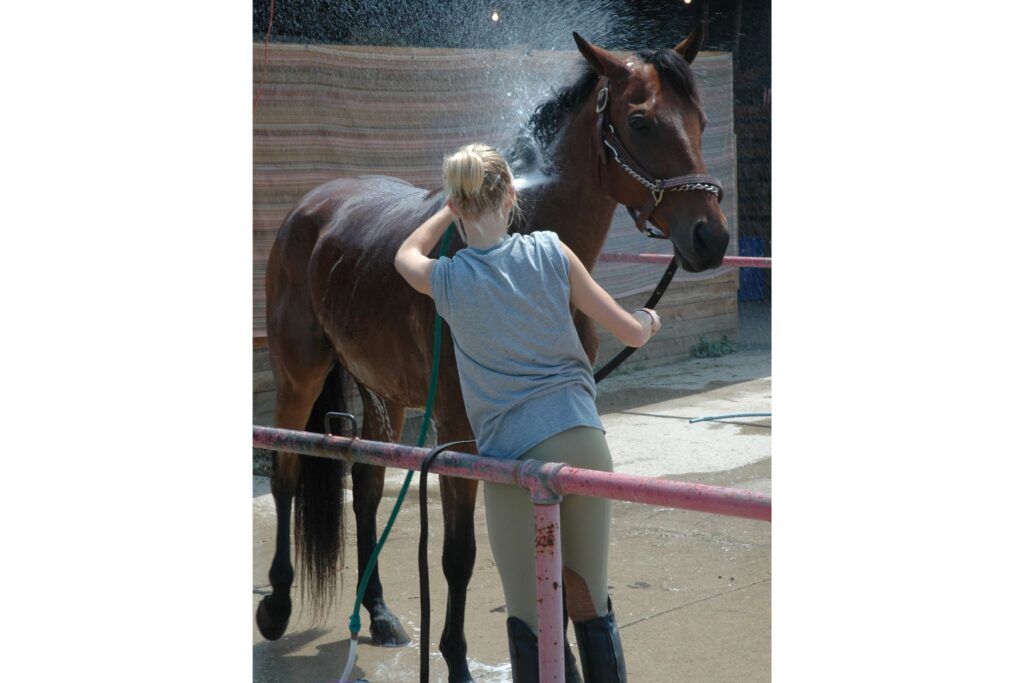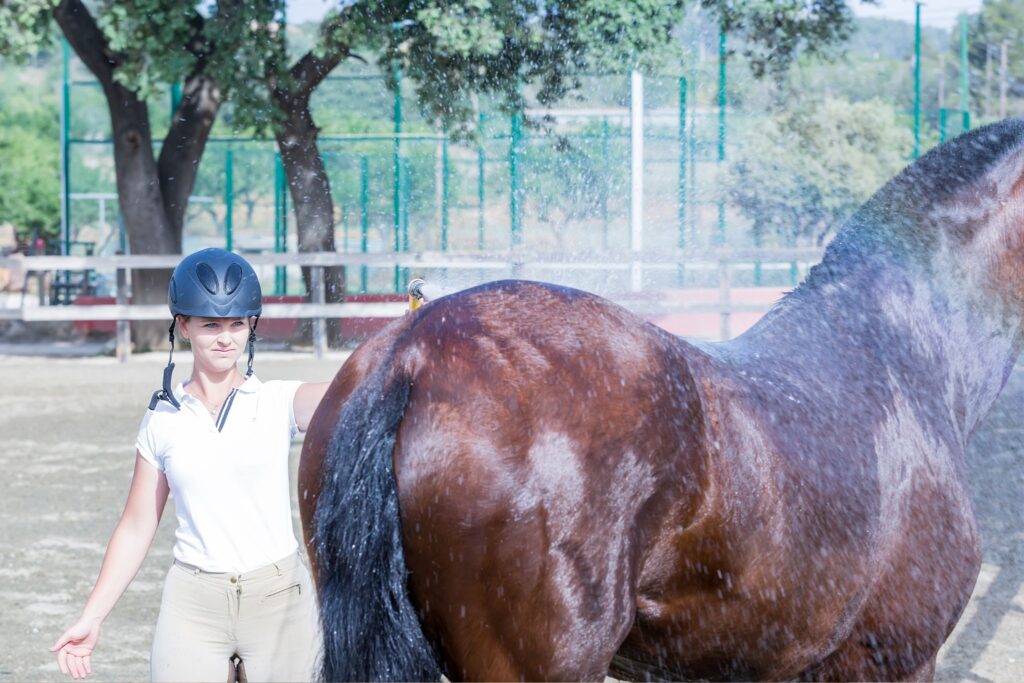Horse News
Member
Equine Bath Time Basics
Have you ever tied your horse to a fence and attempted to wash them off using a hose, while simultaneously creating a mud pit? I sure have! There’s good news though—horse wash racks are a great way to make bath time better for you and your horse.
Situated close to, or even inside the barn, a wash rack is a well-drained place where you can wash your horse, soak hay, and clean out buckets without creating a huge mess that takes longer to clean up than the job you just completed. In this article, I’ll walk you through everything from flooring to water temps for your new sudsy space.

Source: Canva
Wash Racks 101
A wash rack provides a safe and controlled environment in which you can wash your horse, soak hay, and clean out buckets. They usually have gravel or concrete floors with non-slip flooring and a drainage system that collects and disposes of the waste water.
Lead the horse into the wash rack, tie him up, and get to work with your favorite horse shampoo. Before you know it, he’ll be gleaming!
Ideal Wash Rack Sizing
The ideal size for a wash rack is big enough for your horse to stand comfortably while giving you enough space to move around.
A standard-sized wash rack measurement is very similar to that of a horse stall.
A wash rack that’s too small could prove dangerous for the handler, who could get crushed against the side rails. A 16’x16′ spot would be ideal, but they can be smaller.
Best Materials for Wash Rack Stalls
As there’s going to be a lot of water around in a wash rack, you want to use waterproof materials wherever possible.
Galvanized steel poles and side rails are the best as this material resists corrosion and is easy to clean. It’s also expensive, however, which is why many people opt for wooden side rails and poles, even though they deteriorate over time.
Wood is more forgiving if you or your horse do happen to collide with it, and is easy enough to replace if constructed with that eventuality in mind.
If you’re designing an indoor wash rack, you might prefer to use paneling to contain the runoff, rather than poles and side rails. Metal, fiberglass, or water-resistant wood paneling are all effective and relatively easy to clean.

Source: Canva
Flooring for your Wash Rack
The floor needs to be able to cope with lots of water without becoming so slippery that either you or your horse have an accident. It needs to be sloping so that the water can drain away and not leave your horse standing in a puddle.
Concrete is the most popular flooring used in horse wash racks, although this can become slippery when wet and is also hard on your horse’s legs. Scoring the concrete with grooves can make it safer, but it won’t resolve all your problems.
The best approach is to cover the concrete with non-slip rubber matting, similar to that used on the floor of horse stalls.
Wash Rack Logistics
You can build a wash rack either inside your barn or outside, depending on space and climate. If you live somewhere warm and sunny, like Florida, positioning your wash rack outside in the sun is ideal as it will help to keep the area dry, and provide a nice environment for your horse to enjoy its bath.
If you’re constructing an outdoor wash rack, position it on higher ground where it can drain naturally, and close to vegetation that will benefit from the runoff.
The drain should be situated at the back of the wash rack, otherwise, your horse will have to step over it (or in it!) when entering and leaving the area.
An indoor wash rack can be quite imposing for a horse as it’s fully enclosed, so effective lighting is essential, as is a nearby water source or tap.
While you can use an ordinary garden hose in a wash rack, one that’s attached to an overhead boon makes life a lot easier and means you won’t have a coil of hose on the floor waiting to trip you up. It also means your horse can’t stop the flow of water by stubbornly standing on the hose!
Tough 1 Spray Boon
$67.19

Click to see it at Amazon
01/24/2024 12:29 pm GMT
The one thing you can’t live without is a nozzle that allows you to turn the water supply off without leaving the wash rack. This is not only a more sustainably focused option, as it reduces your water usage, it will help eliminate excess water pooling where you may not want it.
RESTMO Garden Hose Nozzle
$19.99

Click to see it at Amazon
01/24/2024 12:29 pm GMT
Another thing to consider is storage space.
Having bottles of shampoo, brushes, and sweat scrapers underfoot while you’re using the wash rack is extremely dangerous, and could injure your horse, so you need somewhere handy to keep those items. A plastic laundry basket will do the job, or you might want to splurge on a wall-mounted cupboard.
Ideal Horse Positioning
To wash your horse effectively, you need to be able to reach every part of his body, which means he needs to be positioned in the middle of the wash rack and tied securely.
In an indoor wash rack, your horse should ideally be facing the aisle so he can see what’s going on around him. In an outdoor wash rack, this isn’t necessary as the side rails give your horse 360° visibility.

Source: Canva
Tying best practices
Cross ties vs. single tie
Cross ties help to keep your horse steady in the center of the wash rack. Cross ties consist of two ties, one on each side. These ties attach to either side of your horse’s halter and prevent him from turning his head or swinging around.
While cross ties are preferable, they may be a luxury depending on the wash rack layout. You can always tie your horse normally, using a lead rope and quick release knot.
Everyone Should Own
Horse Knot Tying Cards
$7.69
We personally know the maker of these cards, and they're incredible references. Pocket-sized and safety-focused, they're made specifically for equestrians who want to learn to tie everyday barn knots and backcountry essentials.

Buy Now
01/24/2024 04:10 am GMT
Quick release knot vs. trailer tie
If you secure your horse in the wash rack using just a single lead rope, it will give your horse much more room for maneuvering, which will make the whole process more time-consuming and potentially dangerous. Your horse could swing his hindquarters around, and squash you against the railings, or even turn around and bite you while you’re busy with his undercarriage.
If you use a lead rope to tie your horse to the wash rack, make sure you use a quick-release knot, so you can free him quickly should he panic.
Trailer ties also are effective as the quick-release snap makes it easy to free your horse if he pulls away or panics. The only problem with using trailer ties in a wash rack is that the exposure to water could cause it to rust or stick, meaning it might not release easily in an emergency.
If you do opt to use a trailer tie, be sure the quick release snap is attached to the wall or railing, not your horse’s halter. If you do need to quickly free your equine, you don’t want your hand that close to their head, and it can be helpful to have something to grab onto when you need to re-capture your spooked animal.
Water Temperature
If your horse is hot after a training session, or simply because it’s a hot day, he’ll be grateful for a cool water rinse-off or bath. If your hose is out in the sun, check the water temperature before using it. The sun will heat the water in the hose to such an extent that it could scald your horse if you don’t let it cool down first.
Having access to hot water is something of a luxury at a barn.
If you have it, it can make bathing a lot more pleasurable for both you and your horse, especially on cooler days.
Again, you need to carefully monitor the temperature of the water to make sure it won’t scald your horse. Horses that have been clipped are particularly sensitive to hot water as they don’t have their natural coats to protect them.
Even if you’ve got access to hot water, it’s not advisable to wash your horse on chilly days when the temperature has dropped below 50℉.
Cleaning the Wash Rack
All the grime and dirt you remove from your horse ends up in the wash rack, so it needs regular cleaning.
After using a wash rack, pick up any manure or hair that could clog the drain, and then hose down the walls, railings, and floor.
If your wash rack has rubber matting, you’ll need to remove this periodically so you can clean the floor underneath. Depending on how frequently you use your wash rack, you may need to do this once a week, or monthly.

Source: Canva
Wash Rack Tools
Your most important wash rack tool is your hose, and it’s well worth investing in a good-quality one that won’t split, crack, or kink. Retractable hose setups are ideal as they rewind automatically, meaning you don’t have lengths of hose to wrestle with.
Grooming Tools
If you’re just rinsing a horse off after a particularly tough training session, you don’t need much besides a hose and a sweat scraper. Sweat scrapers remove the excess water from the horse’s coat, stopping them from dripping water all over the barn and stall, and allowing them to dry quicker.
When preparing your horse for a competition, you want to get every bit of dirt off him, which means a bigger grooming kit!
For a complete bath, you’ll need the following tools:
- Horse shampoo and conditioner
- Rubber curry comb
- Sponge
- Sweat scraper
- Towels for drying
Poop Pickup
Don’t forget, it’s not only your horse that needs to be kept clean, but your wash rack as well, and that means having the necessary tools to clean up after yourself. A dedicated pitchfork, broom and muck bucket will help keep your wash rack pristine.
Frequently Asked Questions
Q: What is a wash rack for horses?
A wash rack is a designated area where you can wash your horse, soak hay, and clean buckets and other equipment. It needs good drainage and access to water.
Q: What size should a horse wash rack be?
A standard wash rack is around the same size as a stall, usually measuring between about 12 feet square.
Q: What is the best material for a horse wash stall?
Waterproof materials like fiberglass and galvanized steel are ideal for a horse wash stall, although wood is cheaper, more forgiving, and easy to replace.
Q: How often do you need to clean a horse wash stall?
You should hose down your horse wash stall after every use, and give it a thorough clean either once a week or once a month, depending on how often you use it. If you’ve got a gray horse, you may need to clean your wash stall every day—just as you do your horse!
Q: How do you clean a horse wash stall?
Remove all manure and hair before hosing down the wash stall and sweeping away the dirt and excess water.
Parting Thoughts
A wash rack makes keeping your horse clean, easier, safer, and more effective. It gives you a designated space that provides good drainage and a secure place to tie your horse while you give him a good scrub.
Positioned correctly, it also means your horse doesn’t have to traipse through mud or dust on his way back to his stall, protecting your hard work!
P.S. Enjoy this article? Trot on over to:
- Curry Confusion: Horse Grooming Terminology
- 6 Best Brush Brands for a Great Grooming Sesh
- Horse care 101: Turnout blankets vs. stable blankets
- Horse Riding Equipment List: What You Need & What You Don’t
- Down ‘n Dirty Horse Barn Cleaning Tips
- Beginner’s Guide to Horse Hay Nets & Bags
- The Ultimate Packing & Horse Trailering Checklist
The post Come Clean: What to Know About Horse Wash Racks appeared first on Horse Rookie.
Continue reading...
